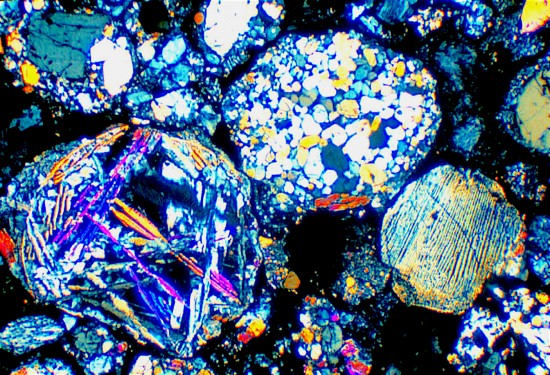
The Tieschitz chondrite. The colored minerals are mainly olivine. Width of image about four millimeters. Credit: University of California, Los Angeles Meteorite Collection.
Nov 16, 2015
Rocky bodies in the Solar System share a common experience.
Recently, a press release from the Massachusetts Institute of technology (MIT) announced the discovery of high temperature minerals in meteorites that goes against the standard interpretation of Solar System formation.
As the article states, meteorites are thought to be “relics” of the Solar System’s earliest epochs because they contain chondrules: glassy spheres of previously molten material. Planetary scientists think that chondrules are a component of planet formation—they “collided” with nebular gas and dust, eventually coalescing into proto-planets.
Researchers from MIT and Purdue University now believe that chondrules “…were not building blocks, but rather byproducts of a violent and messy planetary process.” The reason? High-temperatures needed to melt the minerals that form chondrite, or “stoney” meteorites and their crystalline inclusions.
Iron oxide is found in chondritic meteorites. Since iron oxide forms at temperatures 1000 degrees lower than that required to create minerals like anorthite, forsterite, and olivine how did it find its way into chondrules? The speculation is that they are not the result of planet formation from gas and dust, but result from planetesimal collisions. Once the Nebular Hypothesis collapses a rarified nebula into particles with gravitational attraction, they collect into larger bodies, eventually forming masses just short of planet size. It is the collisions of those objects that are said to provide the heat needed for molten minerals that then condense into hardened droplets.
An earlier report from the University of Chicago noted that, “…if a shock wave formed the chondrules, then the olivine’s isotopic composition would be concentrically zoned, like tree rings….But no one has yet found isotopically zoned olivine crystals in chondrules.”
The dichotomies of high and low temperatures; shockwaves and isostasy; and hardened minerals embedded in softer substrates can be addressed by considering the Electric Universe theory.
The Stardust spacecraft intersected comet Wild 2’s orbit on January 2, 2004, passing through its coma at a distance of 240 kilometers. The aerogel dust-capture system collected fine bits of rock, trapping them inside for their return journey to Earth on January 15, 2006.
Minerals that form only at high temperatures were found. Interestingly, olivine was also collected. Scientists at the time wondered how something that was supposed to be a remnant from a nebular cloud that formed the Solar System could exhibit crystalline structures that would require a blast furnace to create. Anorthite, a compound of calcium, sodium, aluminum and silicate, and diopside, made of calcium magnesium and silicate were found around Wild 2.
When the ill-fated Hayabusa spacecraft finally made it back to Earth there were more than a thousand fragments, none more than a few tenths of a millimeter, inside its collection capsule. The research team was surprised to find that silicates from asteroid Itokawa had at one time been exposed to temperatures in excess of 800 Celsius. Chondritic meteorites are also made of similar stuff. This can only mean that comets, asteroids, and meteoroids share a similar birth.
Physicist and Electric Universe advocate Wal Thornhill argues: “…planets are ‘born’ at intervals by the electrical ejection of charged material from the similarly charged interiors of larger bodies – gas giants from stars, and rocky planets from gas giants…Electrical ejection in a massive internal lightning flash answers the question of the source of the energy. It is not dispersive like an explosion. The electromagnetic pinch effect will produce a jet of matter…The result is a proto-planet plus a stream of gases and meteoric debris.”
Stephen Smith












